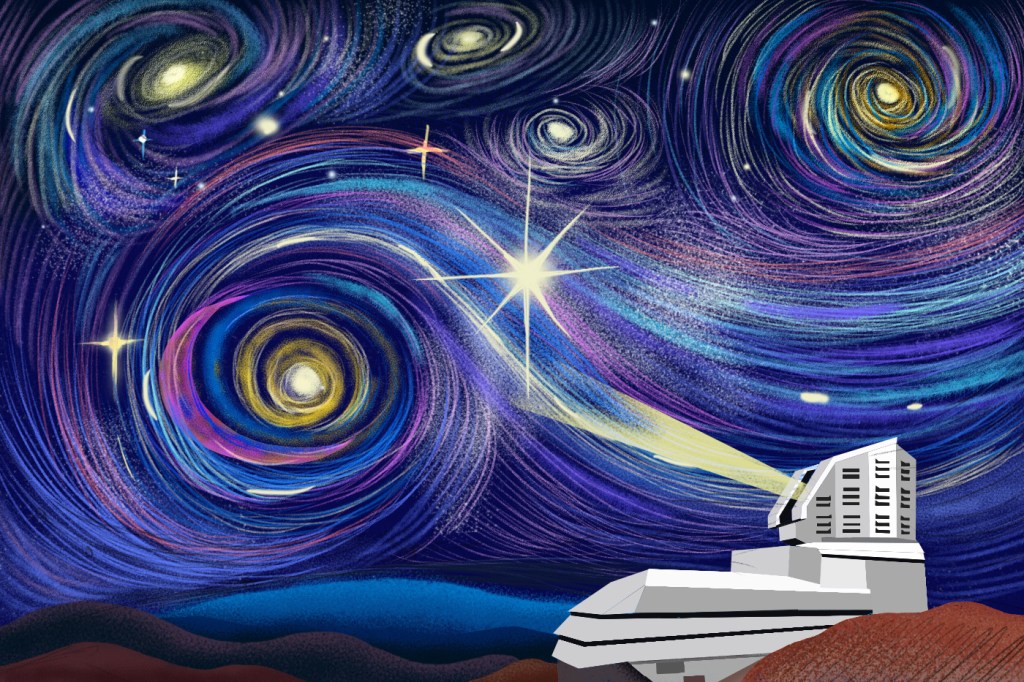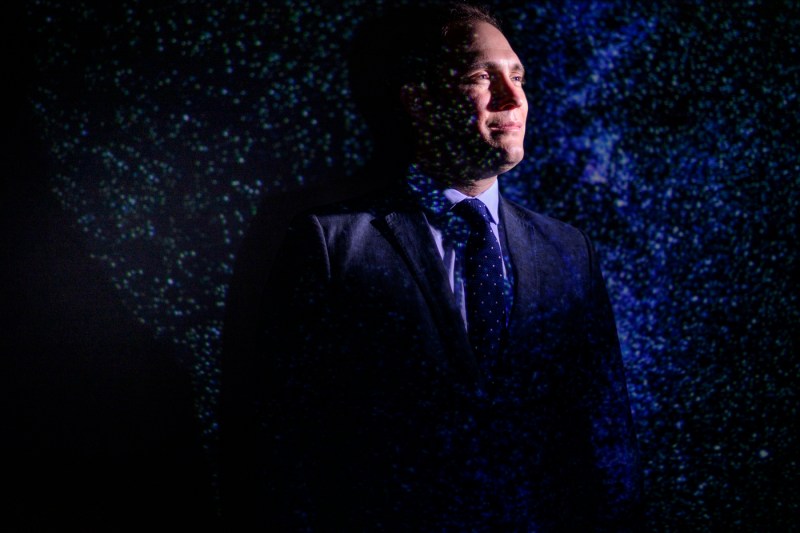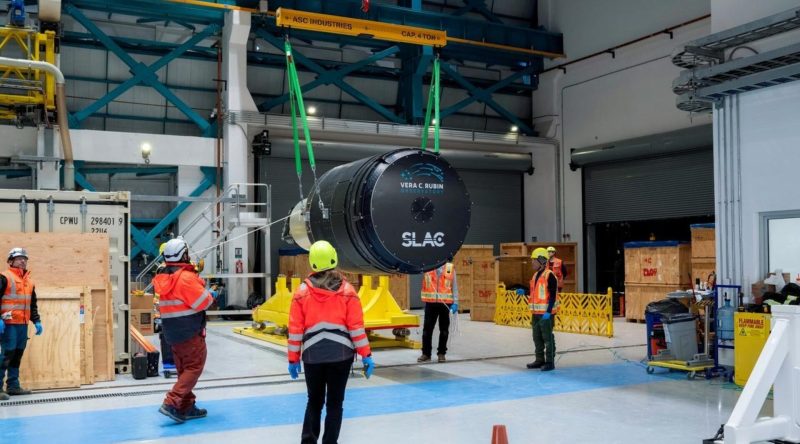Published on
This Northeastern physicist is revolutionizing astronomy with unprecedented dark matter mapping through space observatory in Chile
An expert in observational and theoretical cosmology, Northeastern assistant physics professor Jonathan Blazek is working with an international team of scientists to understand the forces driving the acceleration of the expanding universe.

A new astronomical observatory nearing completion atop a desert mountain in northern Chile will reveal the workings of the universe as never before.
It might even revolutionize our understanding of the mysterious forces shaping the cosmos, such as dark energy, says Northeastern assistant physics professor Jonathan Blazek.
With a telescope as wide as a tennis court and the world’s largest digital camera — about the size of an SUV — the Vera C. Rubin Observatory will collect data and images from the entire visible Southern Hemisphere sky every three nights for a decade.
“This lets you map out large chunks of sky very quickly,” says Blazek, adding that the quality of the images will be “unprecedented.”
The deep and wide survey of the skies is called the Legacy Survey of Space and Time, or LSST. Some are calling it the greatest time-lapse movie ever made, and it’s easy to see why.
The LSST will identify a mind-boggling 10 million changes in the sky every night and discover billions of new stars and galaxies as well as cosmic explosions known as supernovae.
Producing an image of the universe every minute, the survey will explore the origins of the Milky Way and our solar system and look for ways to detect asteroids that pose a hazard to Earth.
Add to these goals the jaw-dropping aspirations of mapping more dark matter than ever before and discovering clues about the mysterious nature of dark energy. That’s where Blazek comes in.
Most of the universe is a mystery
An expert in observational and theoretical cosmology, Blazek is working with an international team of scientists belonging to LSST’s Dark Energy Science Collaboration (DESC) to understand the forces driving the acceleration of the expanding universe.
“The goal is to learn about dark energy and the underlying cosmological model of the universe,” Blazek says.
Dark energy and dark matter are now believed to make up most of the mass of the observable universe, with dark energy accounting for about 70% and dark matter 25%.
This means the stars and galaxies and things we see and understand make up only a tiny fraction of the universe.
The goal is to learn about dark energy and the underlying cosmological model of the universe.
Jonathan Blazek, a Northeastern assistant physics professor
Both dark matter and dark energy are invisible, but they are not the same.
Dark energy is sometimes called anti-gravity or gravity’s evil twin, while dark matter is a gravitational force holding mass together and is sometimes known as cosmic cement or gravitational glue.
“The nature of dark energy is mysterious,” Blazek says. “OK, it’s weird. No one seems to know what it is. It doesn’t seem to act like matter in any normal sense. Instead of pulling the universe together through gravitation, it seems to push it apart.”
Astrophysicists say studying dark matter could hold clues to the nature of dark energy, which could revolutionize our understanding of the cosmos.
Mapping dark matter
But first, scientists have to mark the location of dark matter in the cosmic web.
They believe that dark matter can be revealed by the way its invisible gravitational pull bends light from far-off galaxies, making it appear that galaxies in its path are being viewed through the lens of uneven glass.
“If you look at a bunch of galaxies and you notice that their images all seem to be stretched in the same direction, that’s an indication that probably between you and those galaxies there’s a lot of dark matter,” Blazek says.

He and his colleagues will look at billions of galaxies and use their location and shapes to make a map of not just where the galaxies are located but where they think dark matter exists.
“We can’t directly see it, but we can infer where it is,” Blazek says.
Knowing how dark matter is distributed could help scientists understand how it affects the formation of stars, galaxies and galaxy clusters, he says.
Thanks to the work of astronomers like the late Vera C. Rubin, after whom the observatory is named, “We think dark matter kind of forms the scaffolding on which all the galaxies and other luminous matter exists,” Blazek says.
“By mapping out how the universe expands and how structure in the universe grows, we learn how dark energy is behaving through the history of the universe. Mapping dark matter is an important way to do both of those things.”
The Rubin versus the Webb
Perched atop Cerro Pachon mountain, the Rubin Observatory is likely to run some tests this summer although the full survey program isn’t scheduled to start until 2025, Blazek says.
This spring saw the observatory meet some milestones when the 8.4 meter telescope mirror received its reflective coating, and the digital camera approximately the weight of a Grand Cherokee made the trip to Chile from California, where it was constructed.
“By having such a big telescope and such a big camera, the Rubin Observatory can get very good image quality over a very large field of view. It’s important because there’s a lot of galaxies out there, a lot of sky,” Blazek says.
Mapping the universe with the James Webb telescope that launched in late 2021 would be nearly impossible due to its much smaller, although deeper, field of view, Blazek says.
“There just isn’t enough time. It would be like trying to piece together an entire floor with postage stamps instead of having a carpet,” he says.
By quickly mapping out the sky over and over again, the Rubin Observatory will create a baseline for what the sky normally looks like so that scientists can tell immediately if a supernova suddenly appears or another celestial change occurs.
“They have very clever algorithms that look for stuff that’s changing,” Blazek says. “If something explodes today, you really want to have a telescope on it tomorrow, rather than in a month, because it will change and it will fade.”
“We have something called an alert system which will trigger all these automated systems as soon as something interesting happens,” Blazek says.
For instance, if a powerful and mysterious event known as a gravitational wave were to occur, LSST would search the sky to find an optical counterpart, he says.
A gravitational wave occurs when a couple of massive objects such as black holes fall into each other, spin around and collapse, sending out ripples in spacetime somewhere in the universe.
“This actually bends the fabric of spacetime itself,” Blazek says. “We can detect these now.”
“Let’s say a gravitational wave detector goes off, and the universe is shaking. Something is happening somewhere. We’ll be able to quickly scan that section of sky and say, ‘Oh, I see something going boom, right there.’ We’ll be able to still see the glowing wreckage. This is going to be really great for both physics and astrophysics.”
Revolutionary science
Science writers have referred to the survey as an inventory of the universe.
“The size of the dataset is absolutely revolutionary. We’re increasing by an order of magnitude in terms of how much data we’re collecting and how fast we’ll be able to collect it,” Blazek says.
“Astrophysics is going to expand greatly. We’re going to find a ton of new things, new exploding stars, new things about the solar system and about our galaxy and other galaxies,” Blazek says.
Whether scientists discover a new cosmological model for the universe depends on what they find, he says.
“We have to get a little bit lucky with what the universe is providing to say something is absolutely revolutionary,” Blazek says. “The dream scenario is something totally unexpected strikes, kind of like a bolt from the blue.”

The discovery of dark energy was precisely that kind of bombshell scenario, he says.
Scientists had developed “nice new datasets” about supernovae and thought they would be useful to measure deceleration of the universe’s expansion, Blazek says.
“What they found was that it’s accelerating. So it was a completely unexpected result that was enabled by new techniques and new data,” he says.
Part of Blazek’s role is to make sure that scientists mapping dark matter and exploring the nature of dark energy keep an open mind.
He currently leads a Dark Energy Science Collaboration team that is building a blind analysis pipeline that will allow scientists to make decisions without knowing how they will impact the final result, thus avoiding “experimenter bias.”
“If you know how your decisions impact the result, you will subconsciously make decisions to make things make sense,” Blazek says. “And we don’t want to do that.”
Flying through space — ‘from the comfort of home’
Co-chair of DESC’s meetings committee, Blazek will travel to Zurich in July to join scientists from across the globe. He also regularly meets with colleagues from Harvard, Boston University and MIT as part of an informal group known as “Rubin in Boston.”
The technical marvels associated with the Rubin Observatory, including the sophisticated machinery that will allow the telescope to switch out six 30-inch wide colored lens filters, would fill a book. Or a series.
None of it would be possible without the participation of hundreds of engineers, astronomers, physicists, machine learning and software experts and other individuals from around the world, Blazek says of the survey project, which is being funded by the U.S. National Science Foundation and U.S. Department of Energy.
Featured Posts
“As far as I’m aware, Rubin is the biggest astronomical collaboration that we’ve ever had,” Blazek says.
And it’s all open access, he says.
Unlike the situation with other groundbreaking telescopes, when astronomers have to wait their turn to view the cosmos, information from the survey will be available to both research institutions and interested astronomers.
The Rubin Observatory says that thanks to partnerships with platforms such as Google Earth, “LSST will build a 3-D virtual map of the cosmos, allowing the public to fly through space from the comfort of home.”
A golden age
“I think it’s fair to say that it’s a golden age in terms of the amount and quality of data that we’re going to be able to collect,” Blazek says. “Hopefully, that leads to a golden age of discovery.”
Mapping dark matter is one thing, he says. Discovering the nature of dark energy, the theoretical force driving the universe apart, is another.
Blazek says at this time scientists may need a deeper understanding of both astrophysics and particle physics to take what will be very precise measurements from billions of galaxies and learn what is lurking beneath the current cosmological model.
“You have to both have a transformational dataset and be at a point where your understanding can be impacted by that dataset,” he says.
“If things go well,” Blazek says, “in 10 years we’ll be talking about how to do an even bigger thing to get the stuff we’ve missed. There are galaxies out there that we’re not going to be able to see because they’re too far away. Maybe that’s what I’ll be working on.”
Cynthia McCormick Hibbert is a Northeastern Global News reporter. Email her at c.hibbert@northeastern.edu or contact her on X/Twitter @HibbertCynthia.











